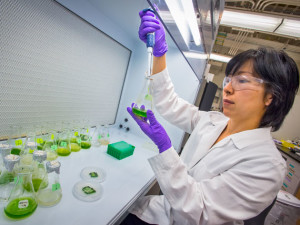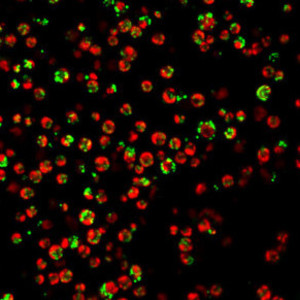Researchers gain better understanding of algae lipid production



Image: Rita Kuo, DOE JGI
August 10, 2015
BY Ron Kotrba
A team led by scientists from the U.S. DOE Joint Genome Institute has analyzed the genes activated during algal lipid production, particularly the molecular machinery that orchestrates these gene activities inside the cell when it produces lipids.
“We know how to stress the algae,” said the study’s first author Chew Yee Ngan of the DOE JGI. “What we don’t know is how to keep the algae alive at the same time, until now.”
Researchers have walked a fine line between stressing the algae enough to produce lipids but not enough to kill them.
Until now, little was known about the protein factor that can regulate lipid production in Chlamydomonas reinhardtii, the reference genome for which was released in 2007.
Advertisement
Advertisement
The team cultured Chlamydomonas reinhardtii cells and starved them of nitrogen or sulfur, both of which are stress conditions to which the algae respond by producing lipids. Then the researchers analyzed the complex of DNA and proteins known as chromatin that define what genes are being activated, as well as the expression profiles or transcriptome, and compared these to nonstressed cells.
“We’re looking for changes in starved cells versus cells that are happily growing,” Ngan explained. Through careful analysis of genome-wide data sets, they narrowed down their search to identify two transcription factors that appeared to play a pivotal role in lipid accumulation, and then studied one of them, PSR1, in detail.
“In studying the chromatin modifications, we can read out changes in the proteins bound to DNA on a genome-wide scale and then specifically target those genes whose regulation profiles are changed under lipid-producing conditions,” Ngan said.
Study co-author Axel Visel, DOE JGI deputy for science programs, said, “The study also demonstrated how cells can be tricked into producing lots of lipid without dying of starvation by overexpression of PSR1, which is a strategy that could potentially be applied in other industrial algal species better suited for large-scale biofuel production.”
Advertisement
Advertisement
While the work is expected to help algal bioenergy researchers develop more targeted approaches for producing lipids for fuels, corresponding author Chia-Lin Wei, head of DOE JGI’s Sequencing Technologies Program, pointed out that this study also successfully demonstrated an effective strategy for the integration of epigenomic and gene expression data and methods—the mapping of molecular tags that sit on top of the actual DNA sequence and affect its function—in an organism relevant to DOE missions in energy and environment.
“Such functional interrogation of the genomes, as part of the JGI’s 10-Year Strategic Vision, is expected to be widely applicable to more plants and fungi whose gene regulatory pathways still prove elusive,” Wei said, adding that Ngan and others at the DOE JGI are continuing this work in many other energy-related species.
Their work was published online July 27 in the journal Nature Plants.
Related Stories
The USDA significantly increased its estimate for 2025-’26 soybean oil use in biofuel production in its latest World Agricultural Supply and Demand Estimates report, released July 11. The outlook for soybean production was revised down.
U.S. fuel ethanol capacity fell slightly in April, while biodiesel and renewable diesel capacity held steady, according to data released by the U.S. EIA on June 30. Feedstock consumption was down when compared to the previous month.
The U.S. EPA on July 8 hosted virtual public hearing to gather input on the agency’s recently released proposed rule to set 2026 and 2027 RFS RVOs. Members of the biofuel industry were among those to offer testimony during the event.
The USDA’s Risk Management Agency is implementing multiple changes to the Camelina pilot insurance program for the 2026 and succeeding crop years. The changes will expand coverage options and provide greater flexibility for producers.
The USDA’s National Agricultural Statistics Service on June 30 released its annual Acreage report, estimating that 83.4 million acres of soybeans have been planted in the U.S. this year, down 4% when compared to 2024.
Upcoming Events










